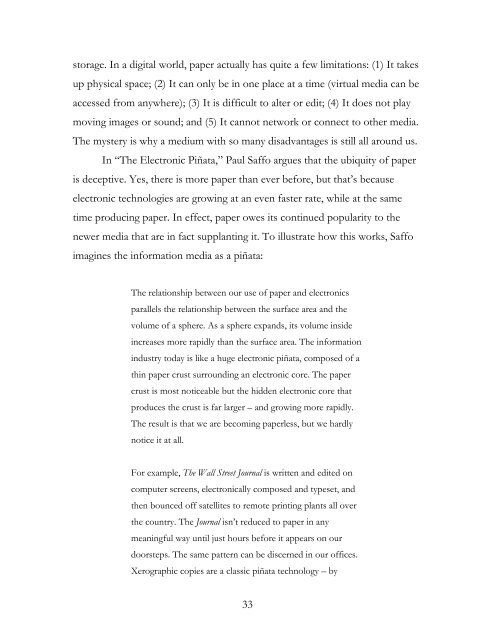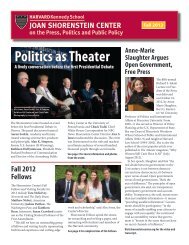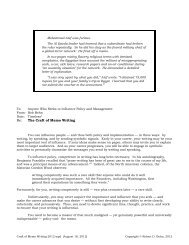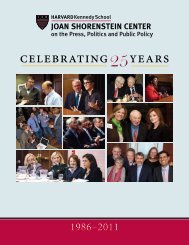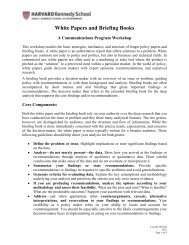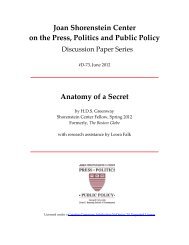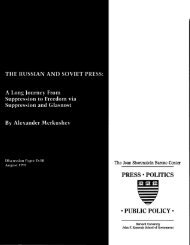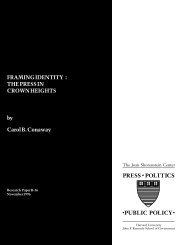Why Paper Is Eternal - Joan Shorenstein Center on the Press ...
Why Paper Is Eternal - Joan Shorenstein Center on the Press ...
Why Paper Is Eternal - Joan Shorenstein Center on the Press ...
Create successful ePaper yourself
Turn your PDF publications into a flip-book with our unique Google optimized e-Paper software.
storage. In a digital world, paper actually has quite a few limitati<strong>on</strong>s: (1) It takes<br />
up physical space; (2) It can <strong>on</strong>ly be in <strong>on</strong>e place at a time (virtual media can be<br />
accessed from anywhere); (3) It is difficult to alter or edit; (4) It does not play<br />
moving images or sound; and (5) It cannot network or c<strong>on</strong>nect to o<strong>the</strong>r media.<br />
The mystery is why a medium with so many disadvantages is still all around us.<br />
In “The Electr<strong>on</strong>ic Piñata,” Paul Saffo argues that <strong>the</strong> ubiquity of paper<br />
is deceptive. Yes, <strong>the</strong>re is more paper than ever before, but that’s because<br />
electr<strong>on</strong>ic technologies are growing at an even faster rate, while at <strong>the</strong> same<br />
time producing paper. In effect, paper owes its c<strong>on</strong>tinued popularity to <strong>the</strong><br />
newer media that are in fact supplanting it. To illustrate how this works, Saffo<br />
imagines <strong>the</strong> informati<strong>on</strong> media as a piñata:<br />
The relati<strong>on</strong>ship between our use of paper and electr<strong>on</strong>ics<br />
parallels <strong>the</strong> relati<strong>on</strong>ship between <strong>the</strong> surface area and <strong>the</strong><br />
volume of a sphere. As a sphere expands, its volume inside<br />
increases more rapidly than <strong>the</strong> surface area. The informati<strong>on</strong><br />
industry today is like a huge electr<strong>on</strong>ic piñata, composed of a<br />
thin paper crust surrounding an electr<strong>on</strong>ic core. The paper<br />
crust is most noticeable but <strong>the</strong> hidden electr<strong>on</strong>ic core that<br />
produces <strong>the</strong> crust is far larger – and growing more rapidly.<br />
The result is that we are becoming paperless, but we hardly<br />
notice it at all.<br />
For example, The Wall Street Journal is written and edited <strong>on</strong><br />
computer screens, electr<strong>on</strong>ically composed and typeset, and<br />
<strong>the</strong>n bounced off satellites to remote printing plants all over<br />
<strong>the</strong> country. The Journal isn’t reduced to paper in any<br />
meaningful way until just hours before it appears <strong>on</strong> our<br />
doorsteps. The same pattern can be discerned in our offices.<br />
Xerographic copies are a classic piñata technology – by<br />
33


